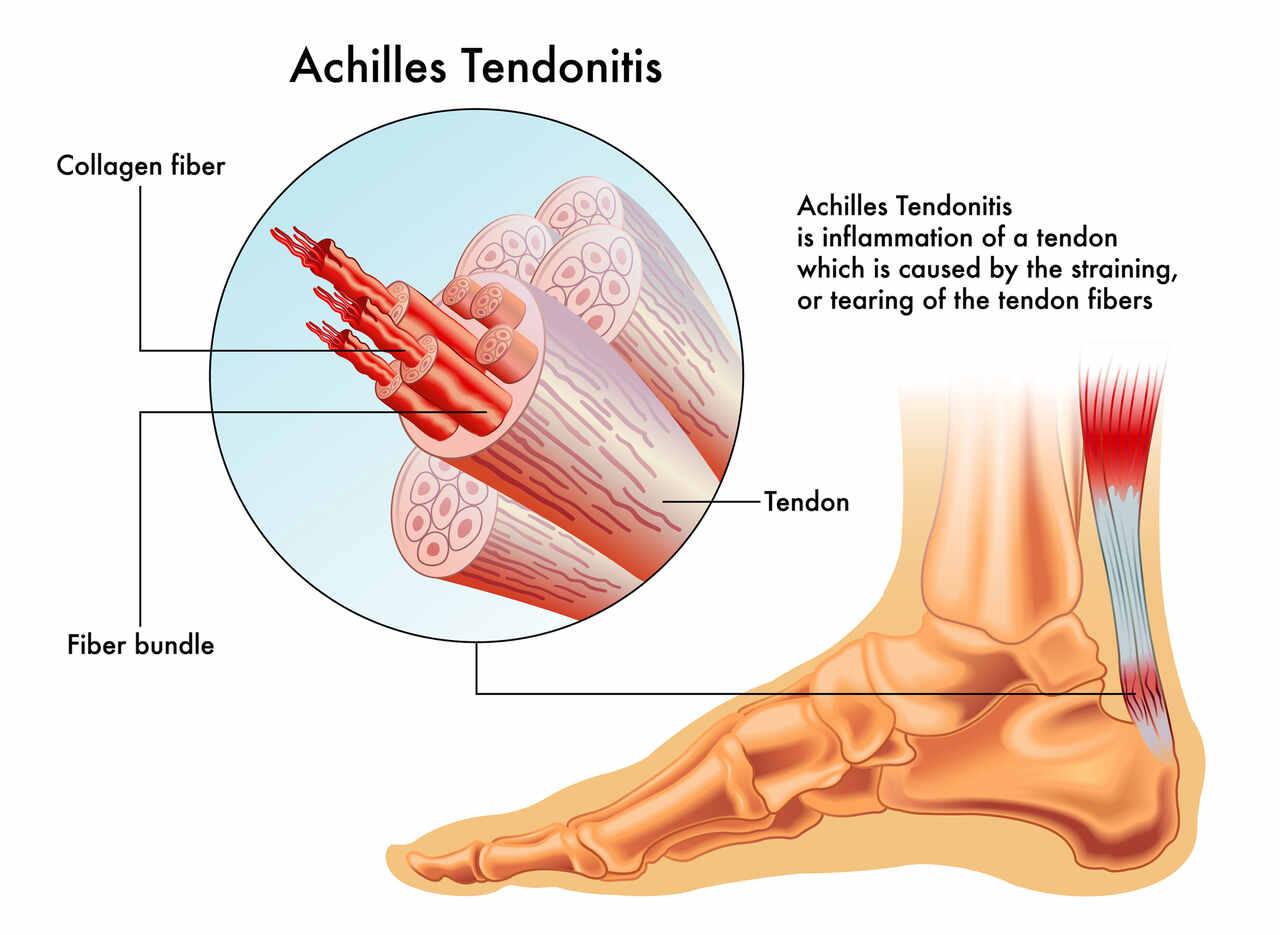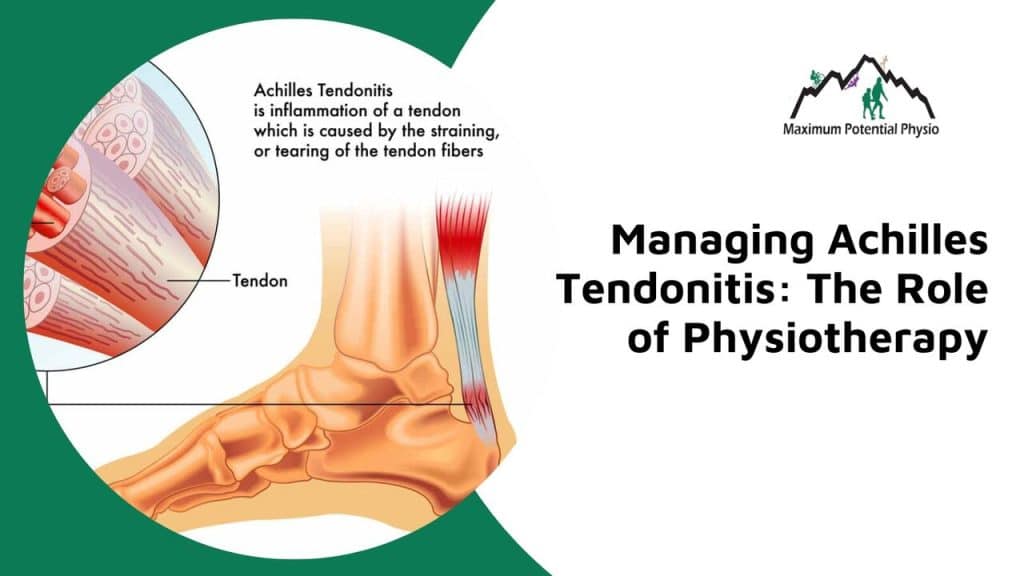Managing Achilles Tendonitis: The Role of Physiotherapy

Achilles tendonitis is a common condition that causes pain and inflammation along the back of the leg near the heel. Understanding the causes, symptoms, and treatment options for Achilles tendonitis, particularly through physiotherapy, can help alleviate pain and improve mobility for those affected.
What is Achilles Tendonitis and What Causes It?
Achilles tendonitis refers to inflammation of the Achilles tendon, which connects the calf muscles to the heel bone. This tendon plays a crucial role in walking, running, and jumping.
Achilles tendonitis is typically caused by:
- Overuse: Repetitive stress on the tendon from activities such as running, jumping, and other high-impact sports can lead to inflammation and pain.
- Sudden Increase in Activity: Rapidly increasing the intensity or duration of physical activity can strain the Achilles tendon.
- Improper Footwear: Wearing shoes that do not provide adequate support can contribute to the development of Achilles tendonitis.
- Tight Calf Muscles: Limited flexibility in the calf muscles increases tension on the Achilles tendon.
- Biomechanical Issues: Problems such as flat feet, high arches, or abnormal gait patterns can place additional stress on the tendon.
Common Symptoms of Achilles Tendonitis
The symptoms of Achilles tendonitis can vary in severity and may include:
- Pain and Stiffness: Pain along the Achilles tendon, particularly in the morning or after periods of rest, is a common symptom. The pain may worsen with activity.
- Swelling: The affected area may become swollen and tender to the touch.
- Thickening of the Tendon: Chronic inflammation can cause the tendon to thicken and become less flexible.
- Limited Range of Motion: Stiffness and pain can restrict ankle movement, making it difficult to walk or engage in physical activities.
- Warmth and Redness: The area around the tendon may feel warm and appear red due to inflammation.
The Role of Physiotherapy in Achilles Tendonitis Treatment
Physiotherapy is highly effective in managing and treating Achilles tendonitis. Here’s how it can help:
- Initial Assessment: A thorough evaluation by a physiotherapist helps identify the severity of the condition and any contributing factors. This assessment guides the development of a personalized treatment plan.
- Pain Management: Physiotherapists use modalities such as heat and ice, and IMS therapy to reduce pain and inflammation.
- Stretching and Strengthening Exercises: Specific exercises are designed to improve flexibility in the calf muscles and strengthen the Achilles tendon, reducing tension and promoting healing.
- Manual Therapy: Hands-on techniques such as massage and mobilization help improve blood flow, reduce stiffness, and enhance tissue repair.
- Education and Advice: Physiotherapists provide guidance on activity modification, proper footwear, and techniques to prevent further injury.
Recommended Exercises for Achilles Tendonitis Rehabilitation
Exercises play a critical role in the rehabilitation of Achilles tendonitis. These exercises focus on stretching and strengthening the muscles and tendons to promote recovery and prevent recurrence.
- Eccentric Calf Raises: Standing on a step with your heels hanging off the edge, rise onto your toes, and slowly lower your heels below the step level. This exercise helps strengthen the Achilles tendon and calf muscles.
- Calf Stretches: Stand facing a wall with one foot in front of the other. Keep your back leg straight and your heel on the ground as you lean forward. This stretch improves flexibility in the calf muscles and reduces tension on the Achilles tendon.
- Heel Drops: Similar to eccentric calf raises, this exercise involves lowering your heels below the step level to stretch and strengthen the tendon.
- Toe-to-Heel Rock: Rock forward onto your toes and then back onto your heels while standing. This exercise enhances balance and strengthens the lower leg muscles.
- Seated Calf Raises: Sit with your feet flat on the floor and place a weight on your knees. Raise your heels off the ground, hold for a few seconds, and then lower them. This exercise targets the calf muscles and Achilles tendon.
Note: These exercises are general recommendations and may not be suitable for everyone. Consult with a healthcare professional like a physiotherapist to ensure they are appropriate for your specific condition and recovery needs.
Footwear for Managing and Preventing Achilles Tendonitis
Footwear plays a significant role in both the management and prevention of Achilles tendonitis. Proper footwear can help reduce strain on the Achilles tendon, provide adequate support, and enhance overall foot mechanics.
- Supportive Features: Shoes with good arch support and cushioning can absorb impact and reduce the stress placed on the Achilles tendon during walking, running, or other activities. Proper support helps in maintaining correct foot alignment and distributing pressure evenly across the foot.
- Heel Elevation: Footwear with a slight heel lift can reduce the tension on the Achilles tendon by minimizing the stretch required with each step. This is particularly beneficial for individuals with tight calf muscles or those recovering from an Achilles tendon injury.
- Fit and Comfort: Ill-fitting shoes can contribute to poor biomechanics, increasing the risk of Achilles tendonitis. It is important to choose footwear that fits well, offers adequate room for the toes, and supports the natural shape of the foot.
- Activity-Specific Shoes: Different activities require different types of footwear. For example, running shoes are designed to handle the repetitive impact of running, while cross-training shoes offer multi-directional support for various activities. Wearing the right shoes for the activity can prevent undue stress on the Achilles tendon.
Lifestyle Modifications to Help Manage Achilles Tendonitis
In addition to physiotherapy, several lifestyle modifications can aid in the recovery and prevention of Achilles tendonitis:
- Weight Management: Maintaining a healthy weight reduces the load on the Achilles tendon and other lower limb structures, minimizing the risk of injury.
- Gradual Increase in Activity: Gradually increasing the intensity and duration of physical activities allows the Achilles tendon to adapt without becoming overstressed. This helps prevent flare-ups and promotes long-term tendon health.
- Warm-Up and Stretching: Incorporating a proper warm-up routine and stretching exercises before and after activities can enhance flexibility, improve blood flow, and reduce the likelihood of tendon strain.
- Hydration and Nutrition: Staying hydrated and consuming a balanced diet rich in nutrients that support tendon health, such as proteins, vitamins, and minerals, can aid in the recovery and strengthen the Achilles tendon.
- Ergonomic Adjustments: Making ergonomic adjustments at work and during daily activities can prevent repetitive strain on the Achilles tendon. For example, using a footrest or adjusting the height of your workstation can help maintain proper posture and reduce tendon stress.
How Does Achilles Tendonitis Affect Athletic Performance After Recovery?
Achilles tendonitis can have a lasting impact on athletic performance, even after recovery. The extent of this impact depends on the severity of the initial injury and the effectiveness of the rehabilitation process.
After recovery, some individuals may experience a reduced range of motion in the ankle joint due to lingering stiffness or scar tissue. This can affect the efficiency and mechanics of movements such as running, jumping, and changing direction.
Achilles tendonitis can lead to muscle weakness and a decrease in power output from the calf muscles. Strengthening exercises during physiotherapy are crucial to restoring muscle function and ensuring the tendon can handle the demands of athletic activities.
Ongoing physiotherapy can help monitor the tendon’s health and address any issues early on. This proactive approach ensures that you can continue to perform at your best without compromising recovery.
Jump Into Recovery
Achilles tendonitis is a common condition that can significantly impact daily activities and athletic performance. Understanding the causes, symptoms, and effective treatments, including physiotherapy and lifestyle modifications, is crucial for managing and preventing this condition.
If you're struggling with Achilles tendonitis, consider Maximum Potential Physiotherapy in Calgary NW. Our experienced physiotherapists are dedicated to providing personalized care and helping you achieve optimal health and function. Contact us today to start your journey toward a pain-free life.

